Introduction
The Help America Vote Act (HAVA) of 2002 was enacted with strong bipartisan support in response to the shortcomings in election administration exposed during the 2000 presidential election. It established mandatory minimum standards for election administration, created the Elections Assistance Commission (EAC) to assist states in implementing these standards, and authorized the appropriation of federal funds to states to implement those standards. The funds themselves were initially authorized into specific categories geared towards replacing aging election systems, improving the accessibility of the voting process, and helping college students vote.
The vast majority of the more than $3 billion appropriated as part of HAVA’s enactment were distributed in 2003 and 2004. From 2011 through 2017, the federal tap slowed to a trickle, with a total of just $10.4 million in election-related grants appropriated for all states and territories. For almost one-third of the program’s 22 year existence, state and local election officials and governments received no federal election grant funding at all.
In the wake of cybersecurity concerns identified in the 2016 presidential election, the Department of Homeland Security designated elections as critical infrastructure and Congress resumed larger appropriations to states in 2018. They were classified as “election security funds” usable for broad categories including “to enhance technology and make certain election security improvements.” Since 2018, states have received $952 million in election security funds, yet Congress has inconsistently appropriated those funds, with $0 in 2019 and 2021 and decreasing amounts over the most recent appropriations cycles.

Using the most recent EAC financial report from September 2023, this analysis highlights how local and state election officials have utilized their HAVA election security grant funds to date. Unless otherwise noted, all spending figures and percentages refer to September 2023 data. The most recent state narratives were released in 2022, so in some cases state spending may have already increased, but it has not been reflected in their formal filings to the EAC. Unless otherwise noted, projects mentioned are from the 2022 narrative. The reported numbers lag behind current spending, with many of the reports suggesting that these projects are carried into 2024 and beyond.
As this interactive map shows, many states have spent the majority of their grant funds. It is important to note that a lower rate of expenditure is not necessarily a bad thing, just as a high rate is not in and of itself a good thing. Each state spends federal funds on different timelines and to meet unique challenges in election administration.
Source: Issue One analysis of Elections Assistance Commission Reports
While 25 states have spent less than 55% of the HAVA grants they have received, careful analysis of the financial reports and state narratives submitted to the EAC reveal a variety of factors that contribute to lower rates of expenditure, including:
- changing priorities due to the emergence of new threats,
- restrictive state spending laws,
- supply chain constraints, and
- difficulty meeting state match requirements.
In many cases, states have designated funds for use, but have not formally spent them. This is most common due to necessarily slow and complex procurement processes and in some cases implementation delays by state-level agencies.
The most common contributing factor driving the slower rate of spending of funds, however, is the inconsistent and uncertain nature of HAVA appropriations by Congress. State after state has reported to the EAC that the inability to predict how much federal funding they will receive each year has compelled them to adopt conservative, multi-year budgeting plans to ensure the programs these funds support are sustainable over the long term. Budgeting HAVA funds to cover ongoing or recurring costs over several years — for staff salaries, cybersecurity subscriptions, election machine maintenance, etc. — is a necessary outgrowth of the scarcity mindset that inconsistent appropriations create. It is also the main contributor to the pervasive myth that Congress does not need to appropriate more funding because some states have not spent all of their election security grant funds.*
As Amy Burgans, clerk-treasurer for Douglas County, Nevada, highlighted in a recent interview: “We are actually doing a little bit of budget cutting this year for the next fiscal year, just kind of tightening the belt. There is no funding for anything additional. But I would love to have a budget for more equipment.” Without knowing when the next federal appropriation will come, or how large it will be, election officials have two choices: spend the funds solely on short term programs that do not have recurring costs, or budget funds over to last for several years (often five or more) to ensure that major investments can be implemented and annual maintenance and other recurring costs are met. No government program should compel officials to make shortsighted choices simply to make an outdated balance sheet look pretty. Consistent and robust federal funding for elections, along with a thoughtful acknowledgement of the nuances of procurement and budgeting, is essential to keep our elections secure for the long term.
Digging Deeper
Analysis of official state and territory narratives, progress reports, and news reporting revealed some common trends among those states that report lower levels than anticipated in their spending reports. Many states that have spending amounts at or below 55% are using their election security funds to update and improve their voting systems over a multi-year timeline. They are spending funds specifically on central voter registration systems and other large infrastructural projects. These systems have a lifespan of around 10 to 20 years, with most being replaced after 10 years. The total cost of replacing every piece of voting equipment in the country, that was first used 10 or more years ago, is $203 million. But that price does not cover regular maintenance. This means that states must often accumulate multiple years of election security grant appropriations to meet the annual cost of maintaining these election systems.
Additionally, many of the states and territories this report analyzes use HAVA funds for ongoing initiatives, meaning they are not one-time expenditures and must be budgeted on an annual basis. In 2022, the most recent year for which the majority of states have submitted detailed narratives to the EAC, these annual expenditures include: cybersecurity initiatives (19 states), voter registration systems and/or election technology (18 states), trainings not specifically related to cybersecurity (nine states), voter education or public awareness programs (eight states), and voter accessibility efforts (seven states). Each of these initiatives do not cost as much as the voting equipment updates, but states’ need to budget ahead several years to ensure they have sufficient funds to maintain these programs in the long-term contributes to the impression that states are slow to spend their election security grant funds.
State by State Breakdowns
Arkansas: 52% of HAVA funds spent as of September 2023
- The state apportioned the 2020 funds ($3,240,195) for voting equipment replacement and upgrades, including $300,000 in natural disaster preparedness funds. Additional expenditures were allocated for voting registration systems and management ($957,980), and countering cyber vulnerabilities ($858,214). The state also spent $800,000 to update the election night reporting system and comply with Uniformed and Overseas Citizens Absentee Voting Act requirements.
- In 2022, the state did acquire “69 tabulation laptops with the latest software update for counties… to manage election data and generate reports with election results.” It is also worth noting that the secretary of state recently wrote an article where he states, “Election offices need to be equipped with modernized computers, operating systems, and training so that we can continue to successfully thwart attempts to erode confidence in our democratic process,” and notes that “One of the instruments that has been critical to [Arkansas’] ability to ward off threats to our election system has been the support from Congress…”
Colorado: 27% of HAVA funds spent as of September 2023
- 2018, 2020, and 2022 HAVA election funds apportioned for a New Voter Registration Database and Election Management System ($10,000,000; 2023-2024), Voting Equipment Upgrade of Ballot Marking Device Printers ($1,000,000; 2022), additional programs, including table top exercises ($950,000; 2022-2026), and “A Campaign to Dispel Election Mis/Disinformation” ($1,000,000; 2023-2024).
- In Colorado’s 2022 state narrative, the secretary of state emphasizes the need to conserve most of their election security funds to purchase a new statewide voter registration system, while also establishing a timeline for various initiatives to run into the future.
Hawaii: 26% of HAVA funds spent as of September 2023
- Hawaii budgeted its 2018 funds for “improving software and hardware, augmenting staffing, and providing staff training,” including migrating election operations from Windows 7 to Windows 10. The state focused its 2020 funds on “the expansion and improvement of the Statewide Voter Registration System.” In both cases the funds are being drawn down over a multi-year timespan.
- The multi-year budgeting plan that Hawaii has pursued with each of its election security grant infusions explains the bulk of the seemingly slow expenditure of funds. This is a prudent approach considering Congress’ failure to regularly and robustly appropriate election security grants, and because many of the projects involved are software and hardware related, and thus will require long-term maintenance expenses.
Illinois: 50% of HAVA funds spent as of September 2023
- The state narrative apportions the state’s total HAVA election funds to the continuation of the Illinois Cyber Navigator Program ($17,647,968) including the Illinois Century Network, a state-managed network delivering network and internet services to government agencies in Illinois, and Cyber Navigator personnel, who assist local election authorities by providing resources and guidance. The state also allocated funds to Americans with Disabilities Act (ADA) Programs/Accessibility Initiatives ($7,520,390) and Voter Registration Systems ($5,107,801.00).
- Illinois was one of the first states to implement a Cyber Navigators Program with HAVA Election Security Grants. The state budgeted the 2018 HAVA funds to last five years to support this program, which statutorily requires the State Board of Elections put half of all HAVA funds received towards this comprehensive statewide cybersecurity upgrade.
Iowa: 49% of HAVA funds spent as of September 2023
- The narrative apportions the state’s total HAVA election funds ($10,786,086) to voter registration system updates ($1,466,004.60), cybersecurity efforts, voter education, enhancing accessibility ($99,000.00), and training for voting processes.
- From the beginning, Iowa’s secretary of state dedicated the state’s election security grant funds to cybersecurity preparedness and supporting county-level election administration. Long-term plans include replacing the statewide voter registration database and making $10,000 available in cyber grants directly to counties. Notably, in 2018 Iowa used election security funds to pay membership dues and required costs associated with joining the Electronic Registration Information Center (ERIC). However, the state eventually left ERIC as a result of conspiracy theories in 2023, potentially leaving unspent some funds the state had planned to spend.
- In Iowa’s 2022 narrative, the secretary of state explained that their “plans for the HAVA funds remain fluid and will be based on immediate and long-term needs.” The secretary also stated that “Cybersecurity is a race without a finish line and Iowa intends to lead this race.” This cautious approach to spending, along with the money allocated for long-term voting system updates likely explains the low level of expenditures recorded.
Kansas: 40% of HAVA funds spent as of September 2023
- The 2022 state narrative has the budget for the 2022 HAVA election funds ($1,200,000) apportioned in three categories: voter registration systems, cybersecurity, and communication efforts. The secretary of state is in budget year 2 out of a 5 year cycle for these programs.
- Kansas has dedicated the bulk of its election security grant funds to cybersecurity preparation. The state’s plans for FY24 and FY25 allocate 60% of funding for cybersecurity initiatives, but reports on recently completed spending demonstrate 90% of funds expended in that category on programs including “the monitoring of cyber threats against local election offices” and to “improve incident response plans in the event a cyber incident occurred.” Most notably, in their 2018 and 2020 state narratives, Kansas secretaries of state in report to the EAC their concern that these federal funds were not being appropriated in a regular and predictable manner, potentially leaving cash-strapped state and local jurisdictions to maintain programs begun with federal funds if those appropriations did not continue.
- Lacking certainty of federal funding, Kansas secretaries seem to have adopted conservative spending levels to ensure they do not leave local election officials with unfunded mandates should federal funding lapse. As Secretary Scott Schwalb noted in the 2020 narrative, the “cyber landscape changes rapidly, many jurisdictions may not have the ability to continue to adapt and secure elections after the expenditure of these funds.”
Louisiana: 0% of HAVA funds spent as of September 2023
- Louisiana is replacing and upgrading all of their voting equipment and is allocating all federal grant money towards the same.
- The project has been ongoing for nearly a decade, but has hit roadblocks, including a withdrawn request for proposal (RFP) in 2021, leading to another RFP phase that began in January 2024 and is ongoing.
Maine: 48% of HAVA funds spent as of September 2023
- The 2022 narrative budgets the 2022 HAVA election funds ($7,643,743) for voting equipment ($2,250,000; 6 years), voter registration systems ($3,515,000; 3 years), cyber and physical security ($1,200,000), accessibility efforts ($205,100; 2020-2027), voting processes ($250,000), voter education efforts ($132,175; through 2024), and other more indirect costs ($448,017).
- That same narrative states that Maine has a long-term plan to spend its federal funds on large-scale projects: leasing a new ballot scanning and tabulation system and a new voter registration system. Both upgrades have been planned for multiple years, and the funds were set aside for those purposes, but have not yet been meaningfully spent. The state signed a contract for its new voter registration system in April 2022 but the actual expenditure of funds did not begin until Fall 2023, so it was not captured in the most recent EAC report from September 2023. The lease of the new ballot scanning and tabulation system, which was to take place in 2021, was “delayed until the EAC-accredited independent test labs are able to fully test new systems that are compliant with VVSG 2.0, and the EAC is able to certify the new systems.” Once certified systems are available, likely in 2024 or 2025, the state will spend a projected $2,250,000 over the course of the six-year lease.
Maryland: 37% of HAVA funds spent as of September 2023
- The 2022 state narrative describes the budget for the 2022 HAVA election security funds ($1,226,483) as being spent primarily on cyber and physical security.
- Maryland has dedicated large portions of its election security funds for information security/cybersecurity monitoring and mitigation of risks. However, the state has spent relatively little in those areas, in part because the state expects these funds to have to stretch over many years. As the State Board of Election explained: “assessing and mitigating vulnerabilities is a continuous task” requiring careful budgeting and swift changes to priorities when new threats arise.
Michigan: 51% of HAVA funds spent as of September 2023
- The 2022 state narrative has a budget for HAVA election funds apportioned to support a DotGov Migration effort helping localities move their websites to .gov domains ($1,000,000; FY 2022-2026) and Election Day Equipment Upgrades ($700,000; FY 2022-2026).
- Because Michigan replaced its voting systems statewide in 2017 and 2018 (in part using original HAVA grant appropriations), the state did not have any planned large technological expenditures when it received more than $10 million in the 2018 HAVA grant. Since 2020, Michigan has dramatically increased its HAVA grant spending. At the end of 2020, the state had spent less than 10% of the $22.7 million in HAVA grants it had received; three years later it had expended more than half of its $26 million in total grants. This was part of a coherent plan laid out in 2020 to spend just under $12 million worth of HAVA grants on a 4-year timespan. The COVID pandemic caused some changes to planned initiatives that delayed spending.
- After a very slow start in 2018 and 2019, Michigan is spending its election security grant funds quickly on critical upgrades, while maintaining a conservative budgeting approach to account for multi-year expenditures in an environment in which federal funds may not be consistently appropriated.
Minnesota: 41% of HAVA funds spent as of September 2023
- The 2022 narrative apportions the 2022 HAVA election funds for voting equipment and security grants to local jurisdiction ($1,151,122; FY 2023-2026).
- According to the Annual 2022 Financial and Progress Report, the state is spending money on a Chief Information Officer and a “Deputy Cyber Navigator” to support the secretary of state’s Election Security Cyber Navigator. While the state never fully explains how/if the Cyber Navigator Program is supported by HAVA funds, the program is mentioned in the HAVA reports.
- With programs set to run from FY23 until FY26, and HAVA funds potentially being used to carry the salary for the two different Cyber Navigator positions, Minnesota will spend larger portions of its federal funds over the next several years, but remains relatively conservative in its expenditures.
Missouri: 51% of HAVA funds spent as of September 2023
- The budget for the 2022 HAVA election funds ($1,219,482) was allocated to facilitate election security trainings, modernization of Missouri’s Centralized Voter Registration System (MCVR), 24-7 defense monitoring to prevent attempts to corrupt the MCVR, upgrades to election-related computer systems, bolstering physical and electronic election security, utilizing state IT staff assistance for local election authorities, funding other activities that will improve the security of elections for federal office, and lastly grants to local election authorities including but not limited to upgrading and enhancing local election authorities’ computer systems.
- In the 2022 narrative, the secretary of state states his view that election security as the result of continual effort: “Missouri strives to educate, prepare, and equip our state’s election officials with the knowledge and tools essential to operating free and fair elections.”
- Missouri’s low spending number results from the state’s continued funding of ongoing programs that began in 2018, along with the secretary’s locally focused outlook on election security. Additionally, as the window for local election officials to apply for subgrants closed only in September 2023, those funds will register as unspent in the most recent reporting.
Nebraska: 38% of HAVA funds spent as of September 2023
- The 2022 state narrative budgets all of the state’s HAVA election funds ($8,422,268) on: voting equipment, updating voting processes and associated training, updating and supporting the voter registration systems, cybersecurity efforts, voter education, voter accessibility efforts, and election administration.
- Supporting these new infrastructure investments imposes long term costs. As the Secretary explained to the EAC, “annual maintenance, firmware and software license costs for the new equipment is far beyond the amount historically appropriated each year from our state funds for election equipment maintenance.” Maintaining these systems will require the careful budgeting of HAVA funds over a long time span, likely explaining the state’s comparatively low spend through September 2023.
Nevada: 41% of HAVA funds spent as of September 2023
- According to the 2022 narrative, the state has apportioned its HAVA funds ($11,458,286) to support four full-time staff positions in the secretary of state’s office. Two of those positions were previously paid out of state general funds, but due to COVID-related budget cuts, they were moved to HAVA grant funds. Additional spending includes allocations for voting equipment, election auditing, voting registration systems, cybersecurity initiatives, public communication initiatives, improving administration of federal elections, and upgrading staff equipment.
- The majority of the $9 million in 2020 and 2022 HAVA election funds Nevada received have been set aside to pay for a voting system update with an RFP phase planned for completion in 2023. The Annual 2022 Financial and Progress Report also mentions COVID as a major reason for spending realignments and a conservative spending model.
- The long-term budgeting for the new “top-down” voting system, which has not yet factored into expenditures but has been apportioned, and the need to carry the salaries of four full-time employees, explains Nevada’s comparatively low spend.
New Hampshire: 26% of HAVA funds spent as of September 2023
- The 2022 state narrative has the budget for the 2022 HAVA election funds ($1,200,000) apportioned to continuing improvements to how elections are conducted, with the goal of “avoiding disruption and confusion.”
- Under state law (New Hampshire RSA 5:6-d), which was enacted in response to the appropriation of election security funds in 2018, New Hampshire stood up an Election Fund as “distinct and separate from all other funds.” Most notably, the state is required not to expend “any monies in the Election Fund unless the balance in the fund following such expenditures shall be at least 12 times the estimated annual cost of maintaining the programs established to comply with [HAVA]… All monies in the election fund shall be continually appropriated to the department of state and shall not lapse.” The state also mentions in its 2022 report that “maintenance costs” for existing and future programs are “rising.” This means that, by law, New Hampshire must hold back the vast majority of the federal funds it receives for elections, treating the Election Fund as something of an endowment.
- The unique implications of RSA 5:6-d together with major planned spending for FY24/FY25 explains the state’s low spending.
New Jersey: 41% of HAVA funds spent as of September 2023
- According to the 2022 state narrative, the budget for state’s HAVA election funds are primarily apportioned to the “NEW JERSEY VOTES Safe. Simple. Secure” campaign, funding, among other things, a voter education campaign, efforts to recruit poll workers, messaging that educates voters on the whole process, and ensuring messaging is provided in a multitude of languages.
- Page three of the 2022 narrative reports 100% of FY23/FY24/FY25 allocations for “voter education” and only lists allocations for FY25. This conflicts directly with the 2022 narrative itself, and the 2022 Annual Financial and Progress Report, which covers from “03/23/2018” until “09/30/2099.” Both of these list multiple other planned expenditures, such as the ongoing effort the state has to develop a program “to focus on the constant threat of Mis/Dis/Malinformation (MDM) … New Jersey has encountered a tremendous uptick in MDM throughout the last several years. This has unfortunately affected the voters’ confidence in the state’s election process.”
New Mexico: 48% of HAVA funds spent as of September 2023
- The 2022 narrative has a budget that apportions the HAVA election funds ($10,068,836) on: efforts to integrate geographic information systems in the voter verification process, an expansion of the central voting registration system, a three-member team overseeing development of election cybersecurity program, and two full-time IT staff to support all of these efforts.
- The Bureau of Elections in the 2022 narrative states that “New Mexico intends to expend a portion of the funding for immediate improvements prior to the 2022 General Election, while the remainder will be used as needed until spent.” The state’s planned spending for FY24 and FY25 will reduce the unspent funds it holds substantially.
Northern Mariana Islands: 51% of HAVA funds spend as of September 2023
- The budget for the 2020 HAVA election funds spent on COVID expenditures — security measures and hygiene listed as top areas — according to the 2020 Request Letter from the Governor.
- The budget for 2022 HAVA funds went to supporting the election of governor and the lieutenant governor, according to the 2022 Financial and Progress Report from the Islands’ election commission.
- The elections’ division uses HAVA funds on a rolling basis to purchase basic voting equipment/supplies as needed for their elections, meaning that any recent allocations are earmarked for upcoming presidential elections. As presidential elections are more expensive than the gubernatorial ones, the Islands are likely to conserve at a higher rate than in 2022.
Oklahoma: 23% of HAVA funds spent as of September 2023
Puerto Rico: 35% of HAVA funds spend as of September 2023
- The 2020 narrative breaks down the funding that the territory allocated for the voting registration system and management (over $3,100,000) and cybersecurity initiatives (over $600,000).
- In its Annual 2022 Financial and Progress Report, Puerto Rico recorded spending about 17% of its assigned HAVA funds. It appears to have doubled the percent spent between 2022 and 2023, indicating the next reporting period may reveal a notable increase in expenditures. Additionally, the Mid-Year 2022 Financial and Progress Report states that “The State Match related to the FY 2020, for $848,377 is still under revision of the Office of Management and Budget of Puerto Rico.” Without the state match, election funds cannot normally be used.
Rhode Island: 53% of HAVA funds spend as of September 2023
- The 2022 narrative breaks down the funding the state has allocated for voter registration systems and elections equipment ($250,000) and cybersecurity issues ($720,000).
- The state’s spending is not too far off its target spend rate of 55% and many of the state cybersecurity initiatives involve training that are offered on a continuous basis. Additionally, according to the Annual 2022 Financial and Progress Report, “HAVA funds also continued to support the maintenance and security of the state’s Central Voter Registration System.” The state is budgeting out the limited HAVA funds to provide for continuous training and support.
- Disruptions and changing needs caused by the pandemic seem to have been the main cause of the state’s relatively slow drawdown of federal funds. To meet the rise in vote by mail balloting in 2020, the state purchased high-speed signature verification and mail ballot processing machines and in 2022 the state acquired an additional ballot extractor to speed the process of opening mail ballot envelopes. Additionally, the delay of the state bond election from 2020 to spring 2021 forced a year-long delay in rolling out the cyber-focused local grant program, as well as cybersecurity support and training for local election officials.
South Dakota: 37% of HAVA funds spend as of September 2023
- The 2020 narrative breaks down the budget for HAVA funds as follows: Post-election audit systems ($1,000,000), Cybersecurity upgrades ($1,550,000), and COVID response ($3,900,000).
- In the 2020 narrative, the secretary of state explained that they plan to budget the funds “until expended.” In both the Mid-Year and Annual 2022 reports, the secretary reported that funds were being spent “to acquire updated election equipment for the counties. This equipment includes laptops, scanners, and automatic letter openers.” However, after spending around 50% of granted HAVA funds through 2022, South Dakota has not reported spending any federal funds since. During that time, the state received $2 million more in HAVA grants and seemingly spent $0. Incomplete state reporting, particularly the lack of an updated state narrative for 2022, impedes analysis.
Tennessee: 45% of HAVA funds spend as of September 2023
- The 2022 narrative breaks down the budget for HAVA funds as follows: Voting Equipment ($11,400,000), Voter Registration Systems ($4,225,000), Election Auditing ($280,000), Cyber and Physical Security ($3,845,667).
- The Midyear 2022 Financial and Progress Report states that “Subgrants have been authorized for each of Tennessee’s 95 counties to receive $25,000 to make security enhancements. Reimbursements are made to counties as expenses are submitted.” The 2022 Narrative also mentions that “we have and will continue to use election security funds to assist counties in purchasing systems that meet the requirements set out by Congress.” Finally, the narrative states that every county in Tennessee will transition to a system with voter-verifiable paper audit trail by January 1, 2024. Local news confirmed they had made the transition.
- The need to fund an ongoing grant program for security enhancements and the fact that some counties still needed to make the transition to a paper audit trail system until 2024 both explain the slightly-below-expected spending.
Utah: 30% of HAVA funds spent as of September 2023
- The 2022 narrative explains that the state plans to spend HAVA funds on cyber and physical security, a state-wide cybersecurity playbook, educating state election stakeholders, and distributing money to election officials for cyber operations.
- Notably, the Annual 2022 Financial and Progress Report mentions an issue with the outside vendor managing the current voter registration system causing the state to “look to upgrade, rewrite, or purchase a new registration system for use beyond 2024.”
- The need to fund the ongoing training efforts, as well as the state turning its fiscal focus to the procuring of a new voter registration system, explains the lower-than-expected spending.
Vermont: 26% of HAVA funds spent as of September 2023
- The 2022 narrative breaks down the budget for HAVA funds as follows: acquisition of a new statewide election management system ($1,200,000).
- The narrative also states “The purchase price for the EMS is anticipated to significantly exceed the 1 million dollars that will be allocated from this grant, so we do intend and anticipate that the full value of the grant will be put toward this acquisition cost, with the remainder of the cost being covered by other sourced of state and federal funds, as available.” The effort began with the 2020 narrative, “Our office intends to begin the replacement of our current vote tabulators following the 2020 elections. Our goal is to have them in place for the 2022 elections.” It is unclear if Vermont has replaced these systems.
- Vermont’s decision to expend the bulk of its HAVA funds to purchase a new election monitoring system likely explains its low spend number, as those funds have seemingly been set aside but were not expended as of the most recent report to EAC.
Washington: 51% of HAVA funds spent as of September 2023
- The 2022 narrative states that the sole expense for the HAVA funds will be “to improve the stability, usability, resiliency, and security of the centralized voter registration system, VoteWA.”
- The Annual 2022 Financial and Progress Report states: “In only the past half-dozen years or so, counties running Washington elections have suffered a flood from a burst pipe, several instances of internet lines being cut, and a white powder scare that shut down the election office for two days.” The report also expresses a strong desire to hold money in reserve to meet unexpected needs.
- Washington’s focus on disaster preparedness and holding funds in reserve, as well as preparations to purchase a new voter registration system, likely explain the lower-than-expected funding.
Wyoming: 47% of HAVA funds spent as of September 2023
- The 2022 narrative apportions the 2022 HAVA election security funds on cyber and physical security ($425,000), voter registration systems ($425,000), and cyber trainings ($150,000).
- In 2018, Wyoming allocated 90% of its HAVA funds towards replacing outdated voting equipment at the county level. However, the state was unable to spend these funds in FY2018 and FY2019 due to delays finding a statewide voting vendor. They purchased this equipment in 2020. Additional purchases followed in FY2021 for voting equipment including backup memory devices, precinct scanners, and ExpressVote BMD Terminals, as well as equipment made necessary during and after the COVID pandemic. Much of the 2022 funds were geared toward operational updates to the voter registration system (WyoReg). They also included “monthly and annual fees associated with the validation of social security numbers via the Social Security Administration.”
- With the major purchase of voting equipment in 2020, and associated recurring expenses that require long-term budgeting of HAVA funds, the state has allocated but-unspent funds for FY24 and FY25, which likely explains the low reported expenditure. This and the uncertain budgetary environment created by Congress’ inconsistent appropriation of election security funds, help explain why Wyoming’s spending may be slightly lower than expected.
*Note: For more on HAVA funding and state spending patterns see:







